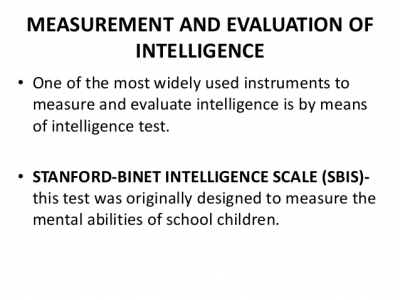How can we measure intelligence Quotient?

Most scientists define intelligence as the ability to learn, understand and analyze things, accompanied by a good memory and imagination. This implies that intelligence is a mixture of several abilities. We know that intelligence level differs from person to person depending upon the aforesaid traits. But can we measure intelligence so that the difference level can be clearly established? Till today neither the above definition of intelligence has been universally accepted nor do the various tests to measure it have a common appeal. In spite of the difficulties, there is one way widely used to measure intelligence — the Intelligence Quotient (IQ) test. But what is IQ?
‘IQ’ is the abbreviation of a psychological phenomenon called ‘Intelligence Quotient’. It is expressed in a number. The IQ of an individual is obtained by dividing his mental age (it is determined by the performance on a standardized intelligence test) by his chronological age and multiplying the result by 100.
The mental age of an individual is determined with the help of different tests. Persons are classified under different categories depending on their IQ scores.

At one time, many psychologists believed that everyone had some degree of inborn intelligence. It was also believed that intelligence was a natural trait like blue eyes, sharp nose etc. and could be ascertained in a single test. But a French psychologist, Alfred Binet, exploded this myth. He worked over this problem in an attempt to develop a test that would help to distinguish between intelligent and dull children. His first tests were given to some French school children in 1905. Later in 1915, these tests were adopted by the German psychologist William Stern and US psychologist Lewis Terman.
Many psychologists believe that these intelligence tests are not the true indicators of one’s intelligence level and therefore do not give a complete picture of the factors that make up intelligence. For example, some tests measure what one has learnt but not how quickly he has learnt. We know that the grasping power of different people is different. They differ in their ability to understand and remember ideas.
They also differ in the use of their knowledge and earlier experiences to solve problems. Hence till today there is no fully accepted definition of intelligence.
It has been, however, concluded that intelligence mainly depends on heredity and the environment. Every person is born with a certain mental ability. The development of that ability may be activated or slowed down by his or her background. The socialization process which includes the environment plays a major role in shaping one’s intelligence. A child becomes a quick learner in areas which he experiences and observes in his day-to-day life. A child who is constantly ridiculed or beaten may develop a complex due to which he or she may not be able to develop his or her intellectual abilities fully. Many children who face discrimination because of race or physical defects fail to develop their mental abilities well. From these facts, it is clear that intelligence is not a natural trait like blue eyes. There is not a single trait that can be called intelligence, nor any single factor which determines it.




